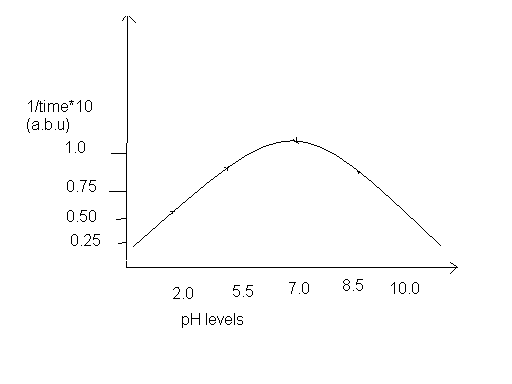The Aim of the Experiment
This paper presents an experiment that was conducted to determine the activity of amylase on starch at various pH levels. The main aim of this experiment was to determine the optimum pH level for action of enzyme amylase on starch.
Introduction
An enzyme is a protein component in the body which acts as a biological catalyst for various metabolic processes. Various enzymes in the body have various roles in which they act on specific substrates and at specific pH levels. In this regard, enzymes work using ‘lock and key’ mechanism model which enhances the specificity of enzymes on particular substrates but not on others. In this model, enzymes have specific active sites compatible with specific active sites for certain substrates. By so doing, specific enzymes would only act on certain substrates which have combatable sites with them but not on others (Asimov 123-137).
It is important to note that, there are various factors which affect enzyme activity like temperature, pH levels, enzyme concentration and substrate concentration among others. As it has been revealed, enzymes act best at optimum temperatures, pH and having the appropriate concentration of substrates. In human body, an example of an enzyme is amylase which is produced in the mouth by sublingual glands as a component of the saliva under the influence of the parasympathetic and symphathatic nervous system. The following experiment was conducted to determine the activity of enzyme amylase, at various pH levels (Asimov 123-137)
Materials and methods
List of equipments and chemicals used
The equipments used in the experiment were tubes tests, several plastic pipettes, two spotting tiles and stop clocks. On the other hand, the chemicals used were five buffer solutions at pH 2.0, 5.5, 7.0, 8.5, 10.0., a concentration of 2% of amylase solution, starch solution and iodine solution.
Procedure of the experiment
First, 3 cm3 of first buffer or pH solution were transferred in a test tube in which 3 cm3 of starch solution were added and the mixture was gently stirred. Afterwards, 3.5cm3 of amylase solution were added into the mixture and then the stop clock was immediately started. The contents of the test tube were then tested for presence of starch at the interval of 1min by withdrawing a few drops of iodine solution the spot for 20mins as the records were being recorded on an enumerated table. This process was repeated for all buffer solutions and the results recorded in enumerated tables as shown below.
Results
The tables below represent the results show the time taken by amylase to show a significant effect on starch at various pH levels.
The following graph shows the overall rate action of amylase on starch at different pH levels.

Interpretation of the results
As it was observed, the rate of activity of amylase on starch under various pH levels was varying. In this case, the highest rate of hydrolysis of starch by amylase was observed at pH level of 7.0. This means that, the optimum level of pH for activity of amylase is 7.0 as it yielded the least level of starch within the shortest period of time. As it was also found, amylase activity on starch at pH levels of 2.0 and 10.0 was almost zero since most of enzymes were denatured by the extreme pH levels (Asimov 123-137).
Considering the ‘key-lock’ mechanism model of enzyme activity, most of the enzymes’ active sites were completely destroyed by the extreme pH levels; leading to the decrease in enzyme activity on the substrates. More specifically, the pH level in the solution affected the active sites of the enzymes by denaturing them leading to their inability to hydrolyze the starch present in the mixture. For instance in set-up 1 of pH 2, the mixture was too acidic to enhance amylase action on the starch as the active sites of the enzymes were denatured (Asimov 123-137).
In set-up 2 of pH 5.5, the mixture was mild acidic which enhanced some enzymatic reaction on the starch, though at a low rate whereas in set-up 3 of pH 7.0, the action of amylase on starch was very high. This is because, at this pH level, the active sites of the enzymes were not affected; and thus acted on the active sites of starch to hydrolyze it. Further, set-up 4 of pH 8.5 enhanced the action of amylase on the starch, though the rate of reaction was low. More so, set 4 of pH 10.0 was observed to have no enzymatic activity of amylase on starch since the pH was too alkaline which led to the denaturing of the enzymes’ active sites (Asimov 123-137).
Evaluation
Though the experiment produced an overview of the theoretical knowledge on enzyme activity, the results obtained might not have been accurate. This is because; some of the contents in the test tubes for various set-ups might have varied in amounts which could have affected the results in a way. For instance, there might have been more starch or amylase solution in some set-ups than in others; thus interfering with accuracy in experiment.
Perhaps, the difference in the amount of contents in the set-ups could have affected the rates of enzymes activity leading to some errors in the experiment results. This is because; enzyme reactivity does not depend on pH levels alone but also on substrate concentration. To improve the results in future experiments, it would be recommendable to use accurate measuring appliances so as to ensure uniformity in the contents involved.
Work cited
Asimov, Isaac. “The Chemicals of Life”. New York: Signet Publishers. (1962): 123-137.